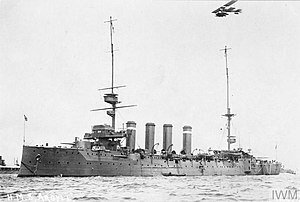 HMS Argyll at anchor, 1909
| |
| History | |
|---|---|
| Name | Argyll |
| Namesake | Argyll |
| Builder | Scotts Shipbuilding & Engineering, Greenock |
| Laid down | 1 September 1902 |
| Launched | 3 March 1904 |
| Completed | December 1905 |
| Fate | Wrecked on the Bell Rock, 28 October 1915 |
| General characteristics | |
| Class and type | Devonshire-class armoured cruiser |
| Displacement | 10,850 long tons (11,020 t) (normal) |
| Length | 473 ft 6 in (144.3 m) (o/a) |
| Beam | 68 ft 6 in (20.9 m) |
| Draught | 24 ft (7.3 m) |
| Installed power |
|
| Propulsion |
|
| Speed | 22 knots (41 km/h; 25 mph) |
| Complement | 610 |
| Armament |
|
| Armour | |
HMS Argyll was one of six Devonshire-class armoured cruisers built for the Royal Navy in the first decade of the 20th century. She was assigned to the 1st Cruiser Squadron of the Channel Fleet upon completion and was transferred to the 5th Cruiser Squadron of the Atlantic Fleet in 1909. Two years later, she was detached to escort the royal yacht during King George V's trip to British India. Argyll was assigned to the 3rd Cruiser Squadron of the reserve Second Fleet in 1913.
Upon mobilisation in mid-1914, her squadron was assigned to the Grand Fleet; Argyll did not see combat before she ran aground and was wrecked in October 1915. Her crew were rescued without loss and the wreck was later salvaged before it was demolished. Nonetheless, it remains diveable.
Cite error: There are <ref group=Note> tags on this page, but the references will not show without a {{reflist|group=Note}} template (see the help page).